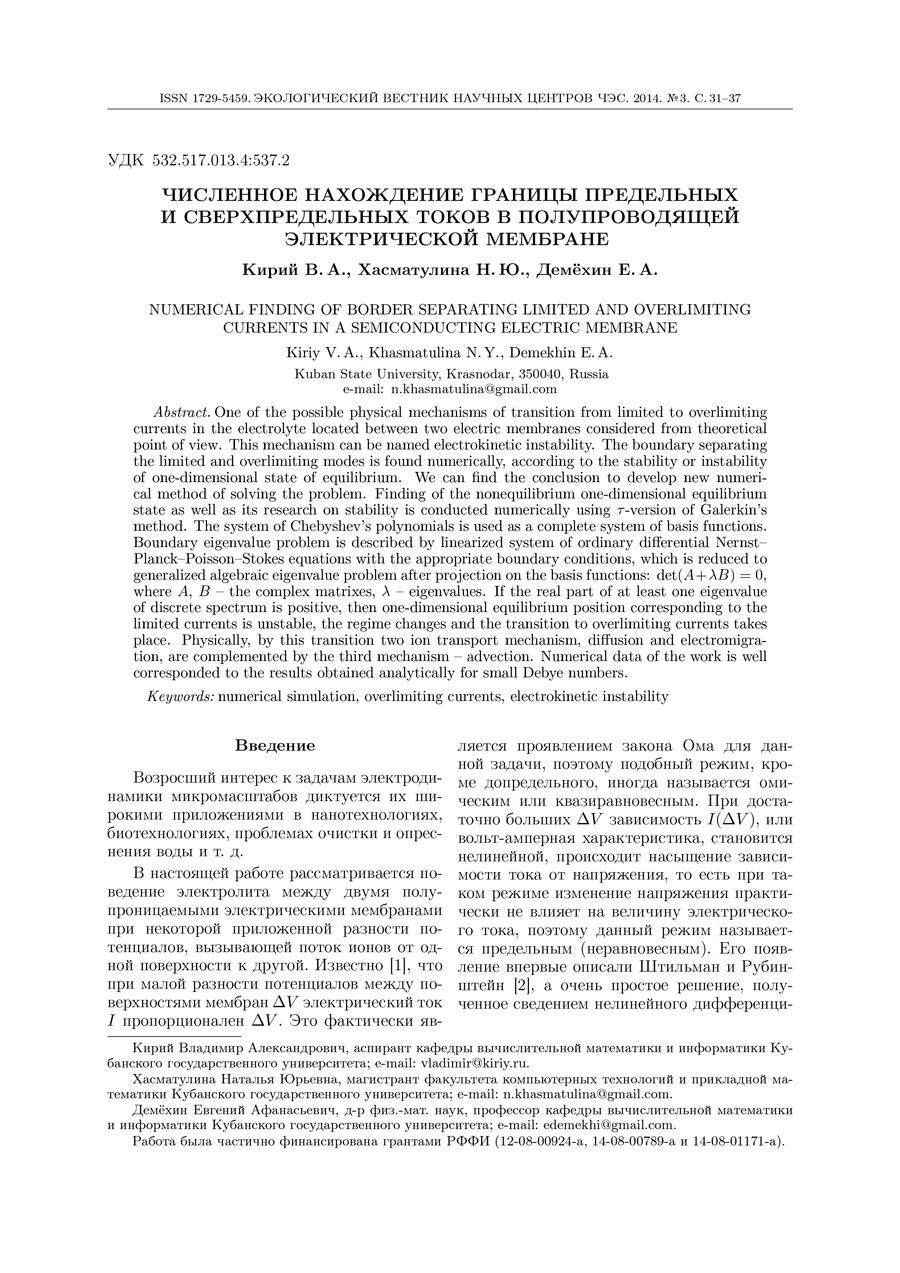Numerical finding of border separating limited and overlimiting currents in a semiconducting electric membrane
UDC
532.517.013.4:537.2Abstract
One of the possible physical mechanisms of transition from limited to overlimiting currents in the electrolyte located between two electric membranes considered from theoretical point of view. This mechanism can be named electrokinetic instability. The boundary separating the limited and overlimiting modes is found numerically, according to the stability or instability of one-dimensional state of equilibrium. We can find the conclusion to develop new numerical method of solving the problem. Finding of the nonequilibrium one-dimensional equilibrium state as well as its research on stability is conducted numerically using $\tau$-version of Galerkin's method. The system of Chebyshev's polynomials is used as a complete system of basis functions. Boundary eigenvalue problem is described by linearized system of ordinary differential Nernst-Planck-Poisson-Stokes equations with the appropriate boundary conditions, which is reduced to generalized algebraic eigenvalue problem after projection on the basis functions: $\text{det}(A+\lambda B)=0$, where $A$, $B$ - the complex matrixes, $\lambda$ - eigenvalues. If the real part of at least one eigenvalue of discrete spectrum is positive, then one-dimensional equilibrium position corresponding to the limited currents is unstable, the regime changes and the transition to overlimiting currents takes place. Physically, by this transition two ion transport mechanism, diffusion and electromigration, are complemented by the third mechanism - advection. Numerical data of the work is well corresponded to the results obtained analytically for small Debye numbers.
Keywords:
numerical simulation, overlimiting currents, electrokinetic instabilityAcknowledgement
References
- Levich V.G. Physicochemical hydrodynamics. Englewood Cliffs, Prentice Hall, 1962, 700 p.
- Rubinstein I. Voltage against current curves of cation exchange membranes. J. Chem. Soc. Faraday Trans. II, 1979, no. 75, pp. 231-246.
- Zabolotsky I.I., Niconenko V.V. Perenos ionov v membrane [Ion's transport in membrane]. Moscow, Nauka Publ., 1996, 392 p. (In Russian)
- Urtenov M.H., Seidov R.R. Matematicheskie modeli elektromembrannyh sistem ochistki vody [Mathematical models of electomembrane systems of water purification]. Krasnodar, KubSU Publ., 2000, 140 p. (In Russian)
- Urtenov M.H., Niconenko V.V. Analiz reshenija kraevoj zadachi dlja uravnenij Nernsta-Planka-Puassona: Sluchaj 1:1 elektrolita [The analysis of the solution of boundary problem for Nernst-Planck-Poisson equations: case of 1:1 electrolyte]. Electrohimia [Eclectrochemistry], 1993, vol. 29, no. 2, pp. 239-245. (In Russian)
- Nikonenko V.V., Kovalenko A., Urtenov M.H., Pismenskaya N.D., Han J., Sistat P., Pourcelly G. Desalination at overlimiting currents: State-of-the-art and perspectives. Desalination, 2014, no. 342, pp. 85-106.
- Rubinstein S.M., Manukyan G., Staicu A., Rubinstein I., Zaltman B., Lammertink R.G.H., Nagele F., Wessling M. Direct observation of nonequilibrium electroosmotic instability. Phys. Rev. Lett., 2008, no. 101, pp. 236101.
- Zaltzman B., Rubinstein I. Electroosmotic slip and electroconvective instability. Fluid Mech., 2007, no. 579, pp. 173-226.
- Demekhin E.A., Shelistov V.S., Polyanskikh S.V. Linear and nonlinear evolution and diffusion layer selection in electrokinetic instability. Phys. Rev. E., 2011, no. 584, pp. 036318.
- Chang H.-C., Yossifon G., Demekhin E.A. Nanoscale electrokinetics and microvortices: How microhydrodynamics affects nanofluidic ion flux. Annu. Rev. Fluid Mech., 2012, no. 44, p. 401-426.
Downloads
Issue
Pages
Submitted
Published
How to Cite
Copyright (c) 2014 Kiriy V.A., Khasmatulina N.Yu., Demekhin E.A.

This work is licensed under a Creative Commons Attribution 4.0 International License.




